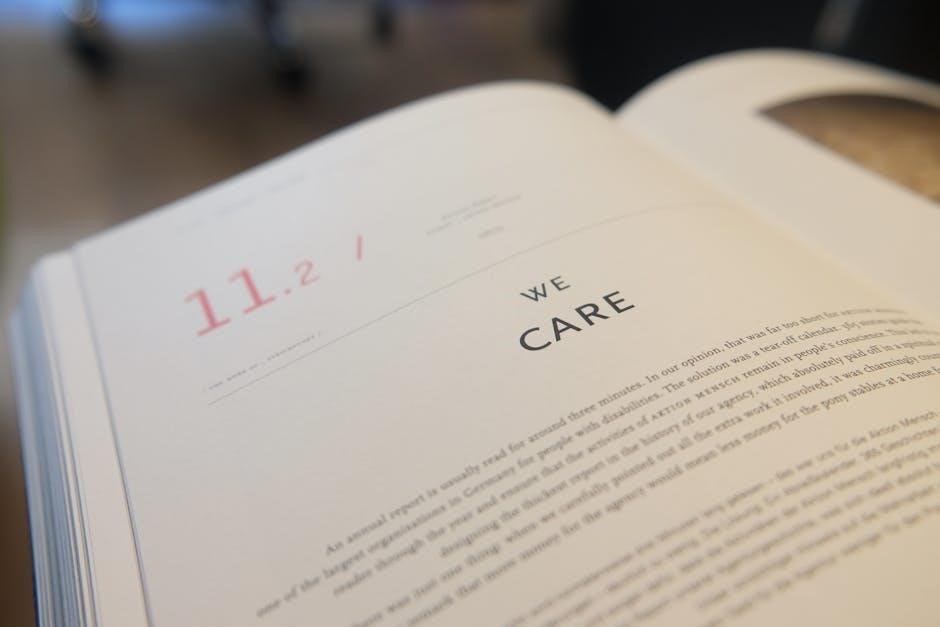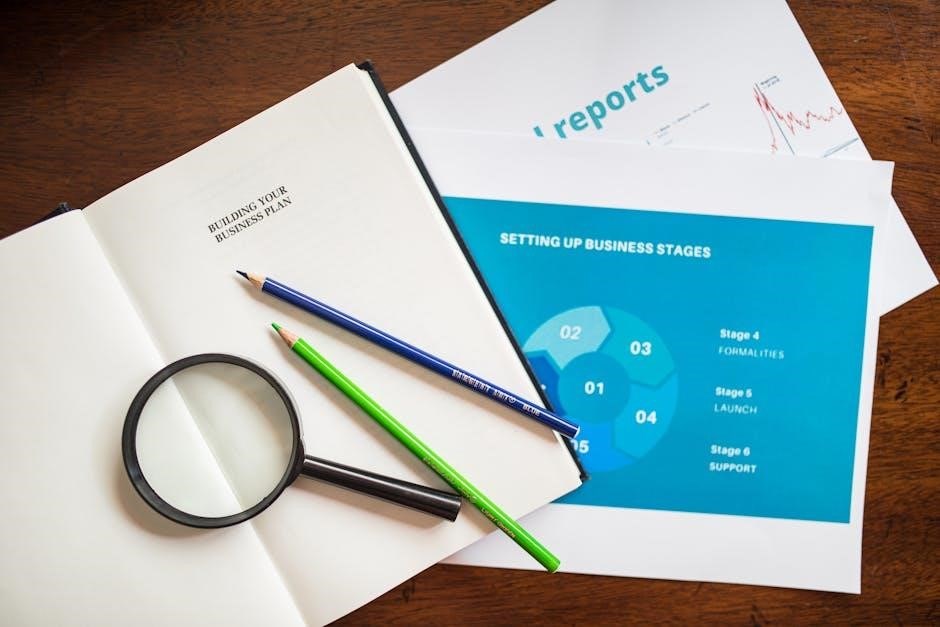A book report format PDF provides a structured template for summarizing and analyzing books, making it easier for students and educators to organize thoughts and present findings clearly․

These templates are customizable, saving time and ensuring consistency, while guiding users through essential sections like summaries, characters, themes, and personal impressions in a professional manner․
What is a Book Report?
A book report is a written summary and analysis of a book, detailing its key elements such as the plot, characters, themes, and personal impressions․ It serves as a tool for understanding and interpreting the content, providing insights into the author’s intent and the book’s significance․ Typically structured in 4-6 paragraphs, a book report varies in complexity, from simple summaries for younger students to detailed critiques for advanced learners․ Its purpose is to demonstrate comprehension, critical thinking, and the ability to articulate thoughts clearly․
Importance of Using a Book Report Template
Using a book report template simplifies the writing process, saving time and reducing workload for both students and educators․ It provides a clear structure, ensuring all essential elements are included, from summaries to personal impressions․ Templates promote consistency and organization, making it easier to present ideas logically․ They also allow for customization, catering to different grade levels or specific assignments․ By guiding users through each section, templates help students stay focused and produce comprehensive, well-formatted reports․ This tool enhances learning and teaching efficiency, making book reporting a more manageable and effective task․
Benefits of PDF Format for Book Reports
The PDF format offers numerous advantages for book reports, including universal compatibility and consistent formatting across devices․ It ensures that the layout and design remain intact, whether viewed on a computer, tablet, or smartphone․ PDFs are also easily shareable and printable, making them ideal for submissions and presentations․ Additionally, PDF templates are highly customizable, allowing users to personalize fonts, colors, and content while maintaining a professional appearance․ This format is particularly beneficial for students and educators, as it streamlines the reporting process and enhances the overall quality of the final output․

Components of a Book Report
Book Information
The book information section provides essential details about the book, including the title, author, publisher, and publication date․ This section also specifies the genre and number of pages, giving readers a clear overview of the book’s context and scope․ Including this information helps establish credibility and ensures the report is well-organized․ It serves as the foundation for the rest of the analysis, making it easier for readers to understand the book’s background and significance․
Main Characters and Setting
This section identifies the main characters and describes their roles in the story, highlighting their traits and interactions․ It also details the setting, including the time and place where the story unfolds․ The setting should be described vividly to help readers visualize the environment and understand its impact on the plot and characters․ Including key locations and the historical or cultural context can enhance the depth of the report, making it more engaging and informative for readers․
Themes and Messages
This section explores the themes and underlying messages in the book, highlighting the author’s central ideas and moral lessons․ It analyzes how these themes are developed through the plot, characters, and setting․ Including specific examples from the text helps illustrate the themes, while explaining their relevance to the story and readers enhances understanding․ The themes often reflect broader societal or emotional truths, making this part of the report deeply insightful and thought-provoking for readers․
Personal Impressions and Conclusion

Types of Book Reports
Book reports vary in complexity, ranging from simple summaries for younger students to detailed analyses for higher grades, ensuring the format matches the educational level and requirements․
Simple Book Report for Lower Grades
A simple book report for lower grades focuses on basic elements, such as the book’s title, author, main characters, and a short summary of the plot․ Designed for younger students, these reports often include space for drawing pictures of characters or settings, making the process engaging and fun․ They also provide guided sections for writing sentences or identifying new vocabulary, helping students develop foundational comprehension and writing skills․ This format is ideal for introducing young learners to the concept of book reporting in an accessible and creative way․
Detailed Book Report for Middle and High School
A detailed book report for middle and high school students requires an in-depth analysis, including plot summary, character development, themes, and personal opinions․ These reports are longer, typically 4-6 paragraphs, and demand a structured approach․ Students are expected to critically evaluate the book, discussing its strengths and weaknesses, and provide evidence-based insights․ The format often includes sections for title, author, genre, and a detailed analysis of key elements․ This type of report helps students enhance their comprehension, analytical skills, and ability to articulate their thoughts effectively, while fostering deeper engagement with the material․
Book Review vs․ Book Report
A book review and a book report are often confused but serve different purposes․ A book report focuses on summarizing the plot, characters, and themes, providing an objective overview․ In contrast, a book review offers a subjective critique, analyzing the book’s strengths, weaknesses, and overall impact․ While a report is more factual, a review expresses personal opinions and evaluations․ Both formats require understanding the content but differ in approach, with reviews often targeting a broader audience interested in whether to read the book, while reports are typically academic assignments for students․

Formatting Guidelines for Book Reports
Book reports should follow clear structure and organization, adhering to academic formatting styles like MLA or APA․ Ensure proper use of headings, margins, and fonts for a professional appearance․
Structure and Organization
A well-structured book report begins with an introduction, followed by sections like summary, analysis, and conclusion․ Use clear headings for each section and maintain logical flow․ Ensure proper spacing and alignment for readability․ Templates often include pre-designed sections for title, author, characters, and personal impressions, guiding users to stay organized․ Customize the structure based on academic requirements or personal preference while keeping the content concise and focused․ This approach ensures clarity and professionalism in the final report․
Academic Formatting Styles
Academic formatting styles like MLA, APA, or Chicago are often required for book reports․ Each style specifies font, margins, and citation guidelines․ For example, MLA uses 12-point font, double-spacing, and a Works Cited page, while APA includes a title page and in-text citations․ Templates for these styles ensure consistency and professionalism, helping students adhere to guidelines․ Proper formatting enhances credibility and demonstrates attention to detail, making the report more polished and academically acceptable․
Tips for Handwritten vs․ Typed Reports
For handwritten reports, use neat cursive and ensure legibility․ Typed reports should follow specific formatting, such as 12-point font and double-spacing․ Both methods require clear organization and proper grammar․ Handwritten reports may include doodles or drawings for younger students, while typed reports benefit from consistent headings and spacing․ Always proofread to avoid errors․ Adhere to teacher guidelines, as some prefer one method over the other․ Using a template can help maintain structure and ensure all sections are included, whether handwritten or typed․

How to Use a Book Report Template PDF
Download the PDF, customize sections to fit your needs, and fill in details like book information, summaries, and personal impressions to streamline your reporting process effectively․
Downloading and Customizing Templates
Downloading a book report template PDF is straightforward, with options available on platforms like Google Drive and educational websites․ Customize the template by adding or removing sections, adjusting fonts, and changing colors to match your needs․ Many templates are fillable, allowing you to input information directly․ Ensure the template aligns with your assignment requirements before use․ Customization helps tailor the report to the specific book and audience, making the process efficient and personalized for students and educators alike․
Filling Out the Template
Filling out a book report template PDF involves systematically addressing each section, such as book information, summary, characters, themes, and personal impressions․ Start by entering the book’s title, author, and publication details․ Next, provide a concise summary of the plot, highlighting key events and themes․ Include descriptions of main characters and their roles․ Finally, add your personal thoughts and conclusions about the book․ Ensure clarity and specificity in each section, and review the template to confirm all parts are completed thoroughly before submission․
Designing Your Own Template
Designing a custom book report template PDF allows for personalized organization and creativity․ Start by outlining essential sections like book information, summary, characters, themes, and personal impressions․ Use user-friendly design tools to arrange these sections logically․ Incorporate placeholders for text, images, or drawings to make the template versatile․ Add visual elements such as borders or color schemes to enhance its appeal․ Save the template in PDF format for easy sharing and ensure it is adaptable to different book genres and reading levels, catering to various educational needs and preferences․

Writing Tips for a Great Book Report
Read with purpose, take notes, and organize ideas․ Stick to the structure, be specific, and add creative touches like drawings or alternate endings to make your report engaging․
Reading with a Purpose
When reading a book for a report, focus on understanding the plot, characters, and themes․ Take notes on key events, memorable quotes, and your reactions to the story․ Identify the main character’s journey, the setting, and how the author conveys their message․ Pay attention to details that reveal the book’s themes and messages․ Note any questions or observations that arise during your reading․ This active engagement ensures your report is comprehensive and insightful, capturing the essence of the book effectively․ By doing so, you’ll have a solid foundation for writing a structured and meaningful book report․
Sticking to the Structure
Adhering to a structured format ensures your book report is clear and organized․ Use a template to guide you through sections like introduction, summary, characters, themes, and personal impressions․ Start with basic information about the book, followed by a concise summary of the plot․ Dedicate paragraphs to analyzing characters, settings, and themes․ Conclude with your personal thoughts and opinions․ This logical flow helps maintain clarity and professionalism, making your report easy to follow and impactful․ By sticking to the structure, you ensure all key elements are covered effectively․
Being Specific and Creative
Enhance your book report by adding specific details and creative elements․ Instead of vague statements, include examples from the text to support your points․ Describe scenes, characters, or quotes that stood out to you․ Encourage creativity by drawing illustrations or imagining alternate endings․ Use clear and descriptive language to convey your thoughts․ Personal anecdotes or reflections can also make your report unique․ This approach not only showcases your understanding but also makes your report engaging and memorable․ By combining specificity with creativity, you transform a standard report into a compelling narrative․

Examples and Samples

Explore various book report format PDF samples, including printable templates and real-life examples․ These resources provide clear outlines and structures to guide your reporting process effectively․
- Printable PDF templates for different grade levels․
- Sample outlines with detailed sections like summaries and character analyses․
- Real-life examples showcasing creative and structured approaches․

Sample Book Report Outline
A sample book report outline provides a clear structure for organizing your thoughts․ It typically includes sections like:
- Plot Summary: Briefly summarize the story without spoilers․
- Characters: Describe main characters and their roles․
- Themes: Discuss key themes and messages․
- Personal Impressions: Share your opinions and reactions․
This outline is ideal for students to ensure they cover all essential elements of a book report in a logical and engaging way․ Customize it to fit your specific needs for a polished and professional result․
Printable Book Report Templates
Printable book report templates are versatile tools designed to help students and educators create structured and organized reports․ Available in PDF format, these templates offer flexibility, allowing users to customize fonts, colors, and content to suit their needs․ Many templates cater to different grade levels, with simpler designs for younger students, including spaces for drawings and handwriting practice․ They often feature fillable fields for key details like book title, author, and plot summary, making the reporting process straightforward and efficient․ These templates are ideal for school assignments, homeschooling, or personal reading projects, ensuring a professional and polished final product․
Real-Life Examples of Book Reports
Real-life examples of book reports provide practical insights into how to structure and present a report effectively․ These examples often include detailed summaries, character analyses, and personal reflections, offering a clear model for students to follow․ Many examples are available online in PDF format, showcasing reports on various books and genres․ They demonstrate how to highlight key themes, discuss plot developments, and express opinions coherently․ By reviewing these examples, students can learn how to organize their thoughts and create comprehensive, engaging book reports tailored to their educational level and requirements․
A book report format PDF is an essential tool for students, helping them present their analysis clearly and professionally․ It enhances learning by improving writing and analytical skills, ensuring a comprehensive understanding of the book and its elements through structured reporting․
Why Book Reports Matter
Book reports are essential for developing critical thinking and analytical skills, as they require students to engage deeply with the material․ They foster a better understanding of literature by encouraging readers to reflect on themes, characters, and plot structures․ Additionally, book reports help improve writing and communication skills, teaching students to express their opinions clearly and concisely․ They also prepare learners for more complex academic writing in the future․ By using a book report format PDF, students can present their ideas in an organized and professional manner, making their work more effective and impactful․
Final Tips for Success
To excel in writing a book report, start by reading with a purpose, jotting down key points like favorite characters or meaningful quotes․ Stick to the structure provided in your PDF template but add personal touches, such as drawings or alternate endings, to make it engaging․ Be specific in your analysis, avoiding vague statements, and share honest opinions about the book․ Encourage creativity, especially in younger students, by allowing them to express their thoughts visually․ Finally, review and revise your work to ensure clarity and accuracy before submission․
